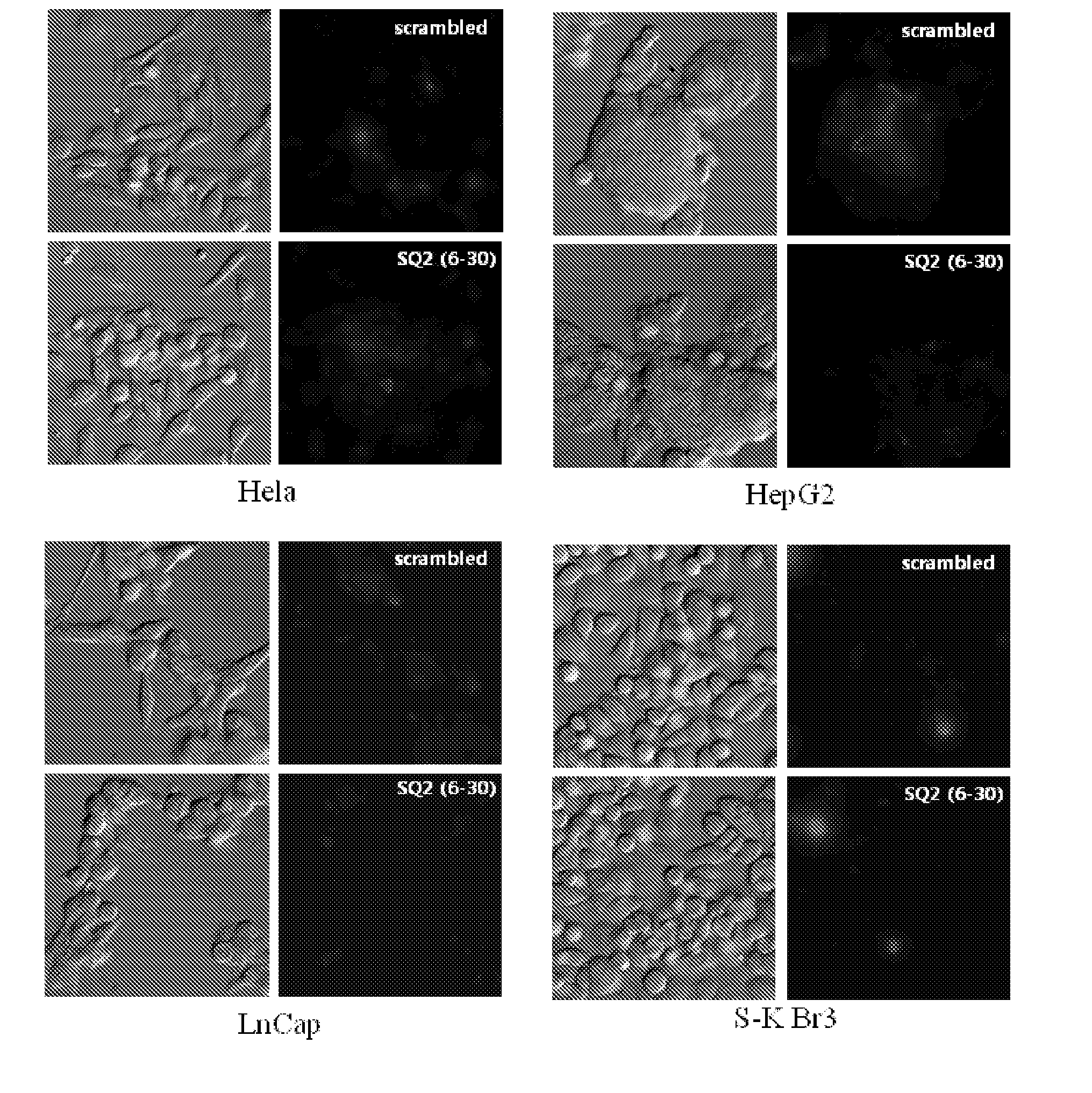Nucleic acid aptamer capable of binding specifically to pancreatic cancer cells or tissues and use thereof
a technology pancreatic cancer, which is applied in the field of nucleic acid aptamer, can solve the problems of limited control of cell-selex technique, significant limitation of membrane protein elucidation using this technique,
- Summary
- Abstract
- Description
- Claims
- Application Information
AI Technical Summary
Benefits of technology
Problems solved by technology
Method used
Image
Examples
example 1
Isolation of Aptamer Binding Specifically to Pancreatic Cancer Cell Line
[0072]1-1: Preparation of ssRNA Library and Primers for PCR Amplification and cDNA Synthesis
[0073]A random ssDNA library having the following sequences was chemically synthesized and isolated by PAGE (Genotech Inc., Korea).
(SEQ ID NO: 16)5′-ATA CCA GCT TAT TCA ATT NNN NNN NNN NNN NNNNNN NNN NNN NNN NNN NNN NNN NNN NAG ATA GTA AGTGCA ATC T-3′
[0074]The initial pool contained 7×1013 molecules. An N40 upstream primer of SEQ ID NO: 17 and an N40 downstream primer of SEQ ID NO: 18 were used for PCR amplification and cDNA synthesis.
Upstream primer:(SEQ ID NO: 17)5′-GGTAATACGACTCACTATAGGGAGATACCAGCTTATTCAATT-3′Downstream primer:(SEQ ID NO: 18)5′-AGATTGCACTTACTATCT-3′
[0075]The amplified library was converted into RNA using Durascribe T7 RNA polymerase (Eqicentre). Herein, 2′-F UTP and 2′-F CTP were used in place of UTP and CTP, respectively, whereby U and C in the resulting RNA had 2′-F in place of 2′-OH so as to increas...
example 2
Measurement of Detection Activity of Aptamer Pool, Selected by Cell-SELEX, for Pancreatic Cancer Cell Line
[0084]2-1: Measurement of Binding Affinity for Pancreatic Cancer Cell Line by Real-Time PCR Assay
[0085]The binding affinities of an initial ssRNA pool and the pools selected in the 5th, 10th and 14th rounds of cell-SELEX were measured by a quantitative RT-PCR assay.
[0086]Specifically, 1×106 cells of each of the Capan-1 and Panc-1 cell lines were treated with 100 nM of each of the initial library and the RNA pools. As a control group, a HPEDE cell line that is a normal human pancreatic cell line was used.
[0087]Both the in-put aptamer pool and the out-put aptamer pool were used as a template for cDNA synthesis. Diluted cDNA of each round was analyzed by quantitative real-time PCR using a Step-One real-time PCR machine (Applied Biosystems) according to the manufacturer's protocol, and the ratio of the output signal to the input signal was calculated. Herein, the PCR amplification w...
example 3
Measurement of Detection Activity of Each Isolated Aptamer for Pancreatic Cancer Cell Line
[0097]3-1: Measurement of Binding Affinity for Pancreatic Cancer Cell Line by Real-Time PCR Assay
[0098]In order to measure the binding affinity of the aptamers, obtained in Example 1, for pancreatic cancer cell lines, the aptamers were subjected to quantitative RT-PCR in the same manner as Example 2-1 using the Capan-1 cell line and the Panc-1 cell line.
[0099]As a result, as shown in FIG. 6, the aptamers had binding affinity for the pancreatic cancer cell lines capan-1 and panc-1. Particularly, SQ2 (SEQ ID NO: 2) and SQ6 (SEQ ID NO: 6) among the aptamers showed very high binding affinities for the two cell lines.
[0100]3-2: Measurement of Dissociation Constant (Kd) for Pancreatic Cancer Cell Line by Equilibrium Filtration Method
[0101]For the SQ2, SQ4, SQ6 and SQ8 aptamers and the SQ1 aptamer showing a high copy number, a binding assay was performed an equilibrium filtration method. Specifically,...
PUM
| Property | Measurement | Unit |
|---|---|---|
| length | aaaaa | aaaaa |
| chemical modification | aaaaa | aaaaa |
| chemical | aaaaa | aaaaa |
Abstract
Description
Claims
Application Information
 Login to View More
Login to View More - R&D
- Intellectual Property
- Life Sciences
- Materials
- Tech Scout
- Unparalleled Data Quality
- Higher Quality Content
- 60% Fewer Hallucinations
Browse by: Latest US Patents, China's latest patents, Technical Efficacy Thesaurus, Application Domain, Technology Topic, Popular Technical Reports.
© 2025 PatSnap. All rights reserved.Legal|Privacy policy|Modern Slavery Act Transparency Statement|Sitemap|About US| Contact US: help@patsnap.com



